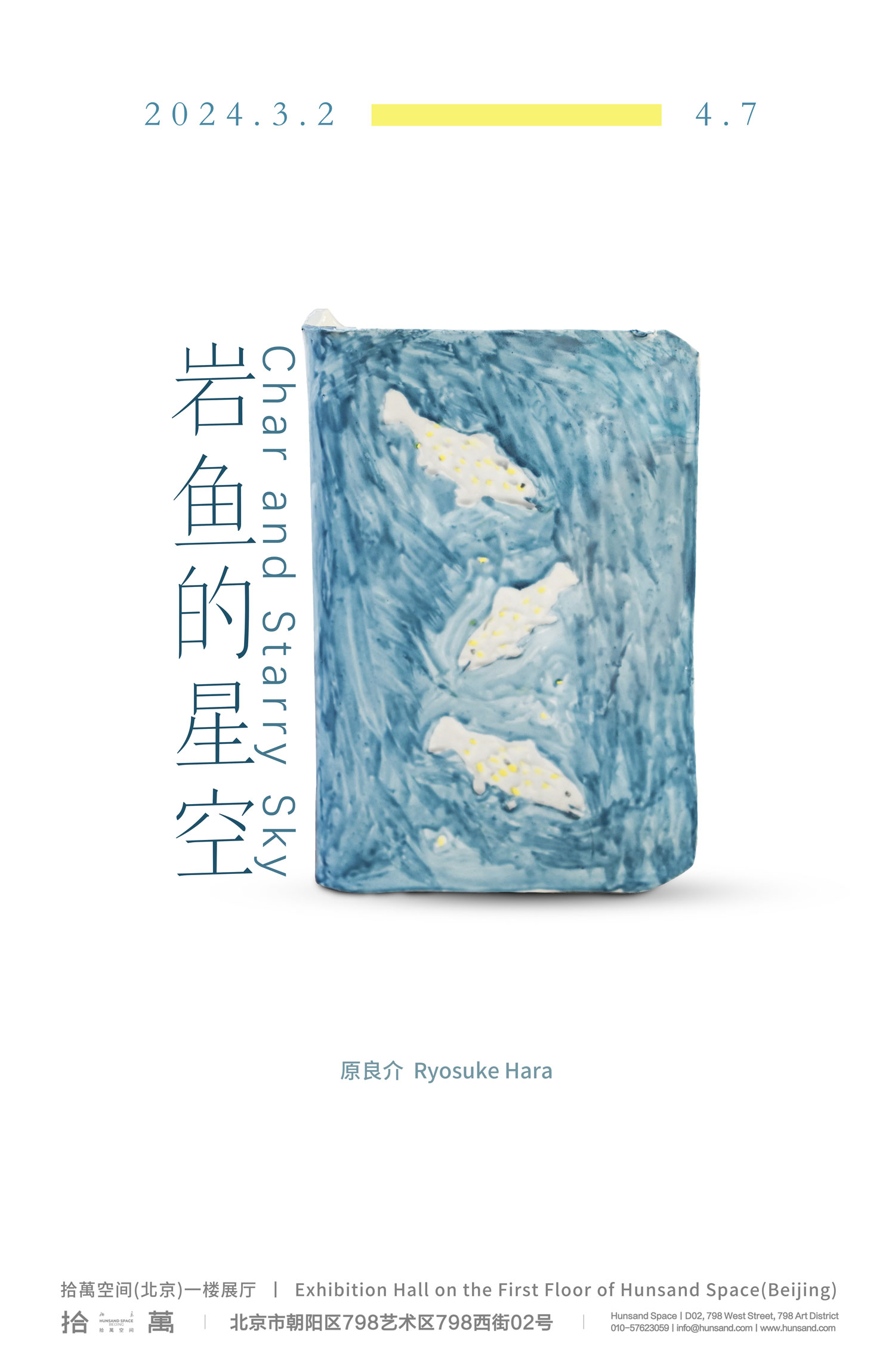展期 Period:
2024.3.2—2024.4.7
艺术家 Artist:
地点 Venue:
新闻稿 Press Release:
拾萬空间(北京)非常荣幸地将于2024年3月2日,在画廊一楼项目空间呈现日本艺术家原良介的个展《岩⻥的星空》。展览名称源自本次展出的同名陶瓷及绘画作品,上面均绘有三条岩鱼。在原良介的创作中,物象经常以三个的量数出现,代表了他对过去、现在、未来三种时态相互依存、影响的指涉和认知。
出生于日本神奈川县的原良介,从小的居住环境毗邻山涧、溪流,在溪水中抓鱼是他儿时重要的娱乐。这里的岩⻥胆小谨慎,通常躲在石头后面,只在夜里没人时才偷偷露出来望着星空。而鳟⻥则行动敏捷,自古就被日本人喜爱,被誉为“溪流的女王”。这些儿时的玩耍记忆一直影响着原良介的创作,并在他的笔下展现出灵动、自在的天性。
几年前,原良介在滋贺县的美秀美术馆看到了日本名僧明惠上人的一件素描作品,瞬间就被其吸引。明惠上人以每晚记录梦境的《梦记》而闻名,但这样的带插图的作品却极为罕见。素描中的水瓶据说代表着观音或弥勒菩萨,而为了探寻瓶中流出的白光究竟代表什么,原良介接连创作了“明惠的白光”系列。画中的白光部分,他没有使用颜料,而是通过削去现成的画布,让本应不存在的地方显现出它的存在;而水瓶的主题,他则选择了小鹿田和苗代川等地民窑烧制的古老壶来进行呈现。这些土地的素材和为当地生活烧制的朴素陶器,同样构成了日本自然与风土的一部分,并成为他重新思考日本人的自然观和艺术观的契机。
明惠上人于1206年在京都栂尾山开设了高山寺,他一生的大部分时间都在山中度过,并以僧侣的身份在大自然中丰富而严酷地生活。高山寺内收藏着《鸟兽戏画》《树座禅像》等日本国宝级的艺术品,以及神鹿的木雕和运庆的犬木雕等动物雕刻的名作,这些作品更是完美体现了日本的自然观、宗教观和艺术观。于是,种种机缘之下,原良介的个人记忆便与历史的经验重叠在一起,最终化身在他创作中的日月星空、游鱼草木这些日常的细小里;而人就若隐若现于这自然之中,并与它们一起,在彼世、现世和来世之间不断地循环。
Hunsand (Beijing) is honored to present Japanese artist Ryosuke Hara's solo exhibition " Char and Starry Sky" in the gallery's first-floor project space on March 2, 2024. The exhibition title originates from the ceramic and painting works displayed, all depicting three Char fish. In Ryosuke Hara 's artworks, objects often appear in sets of three, symbolizing his interdependent and cognitive reference to the past, present, and future.
Born in Kanagawa, Japan, Ryosuke Hara grew up in an environment close to mountain streams and rivers, where catching fish in the streams was his childhood pastime. The char here are timid and usually hide behind rocks, only peeking out at the starry sky when no one is around at night. On the other hand, the trout is agile and has been beloved by the Japanese since ancient times, revered as the "queen of the streams." These childhood memories continue to influence Ryosuke Hara's creations, reflecting the playful and free-spirited nature in his works.
Several years ago, Ryosuke Hara was captivated by a drawing by the renowned Japanese monk Myoe Shonin at the Miho Museum in Shiga. Myoe Shonin was famous for his nightly recordings of dreams in "Dream Records," but such illustrated works were extremely rare. The water bottle in the drawing is said to represent Kannon or Maitreya Bodhisattva, and to explore what the white light flowing out of the bottle symbolized, Ryosuke Hara created the "White Light of Myoe" series in succession. In the white light part of the painting, he did not use pigments but rather removed the existing canvas to reveal its presence in places where it should not exist. For the theme of the water bottle, he chose ancient pots fired in local kilns such as Ontayaki and Naeshirogawa to present. These materials from the land and the simple pottery fired for local life are also part of Japan's nature and climate, providing him with an opportunity to rethink the Japanese perception of nature and art.
Myoe Shonin established Kosho-ji Temple on Mt. Takao in Kyoto in 1206, where he spent most of his life in the mountains, living a rich and rigorous life in nature as a monk. Kosho-ji Temple houses national treasures such as "Birds and Animals at Play" and "Tree-Seated Meditation Images," as well as masterpieces of animal carvings such as divine deer and Eukyong. These works perfectly embody Japan's views on nature, religion, and art. Thus, under various circumstances, Ryosuke Hara's personal memories overlap with historical experiences, ultimately incarnating in his creations of the daily minutiae of the sun, moon, and stars, and the swimming fish and plants; while people are elusive among nature, cycling with them between this world, the present world, and the afterlife.

